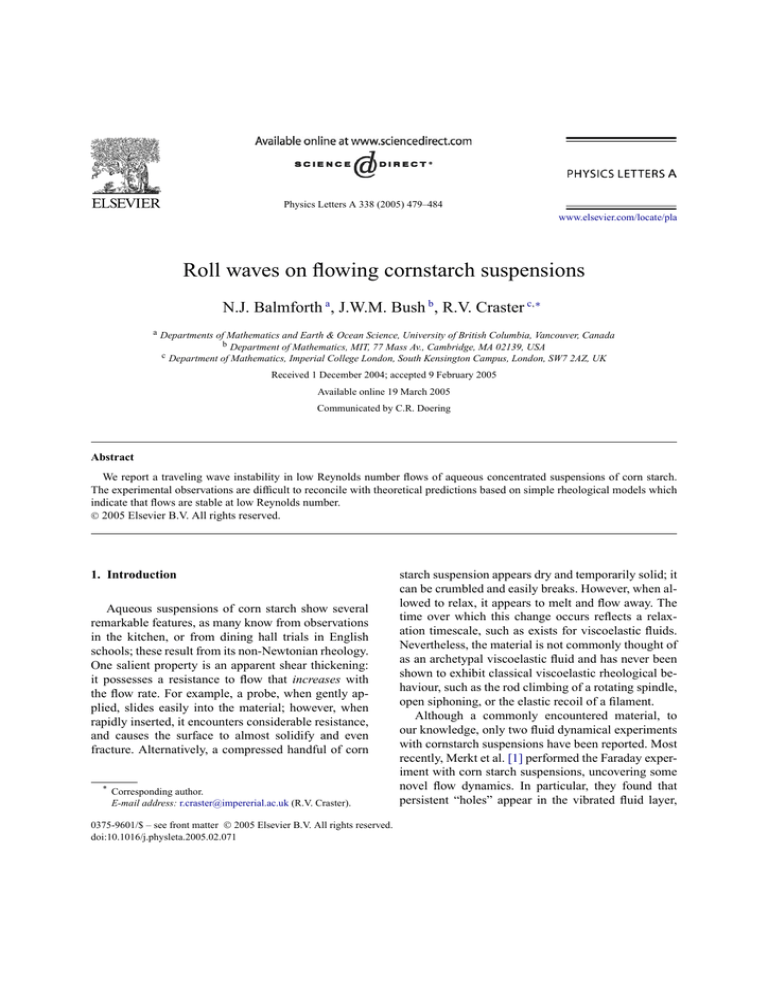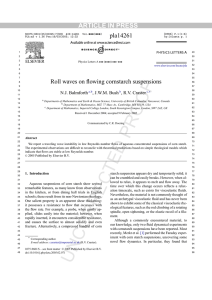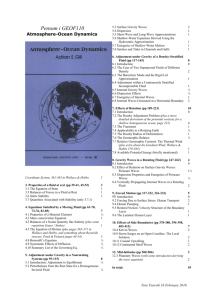
Physics Letters A 338 (2005) 479–484
www.elsevier.com/locate/pla
Roll waves on flowing cornstarch suspensions
N.J. Balmforth a , J.W.M. Bush b , R.V. Craster c,∗
a Departments of Mathematics and Earth & Ocean Science, University of British Columbia, Vancouver, Canada
b Department of Mathematics, MIT, 77 Mass Av., Cambridge, MA 02139, USA
c Department of Mathematics, Imperial College London, South Kensington Campus, London, SW7 2AZ, UK
Received 1 December 2004; accepted 9 February 2005
Available online 19 March 2005
Communicated by C.R. Doering
Abstract
We report a traveling wave instability in low Reynolds number flows of aqueous concentrated suspensions of corn starch.
The experimental observations are difficult to reconcile with theoretical predictions based on simple rheological models which
indicate that flows are stable at low Reynolds number.
2005 Elsevier B.V. All rights reserved.
1. Introduction
Aqueous suspensions of corn starch show several
remarkable features, as many know from observations
in the kitchen, or from dining hall trials in English
schools; these result from its non-Newtonian rheology.
One salient property is an apparent shear thickening:
it possesses a resistance to flow that increases with
the flow rate. For example, a probe, when gently applied, slides easily into the material; however, when
rapidly inserted, it encounters considerable resistance,
and causes the surface to almost solidify and even
fracture. Alternatively, a compressed handful of corn
* Corresponding author.
E-mail address: r.craster@impererial.ac.uk (R.V. Craster).
0375-9601/$ – see front matter 2005 Elsevier B.V. All rights reserved.
doi:10.1016/j.physleta.2005.02.071
starch suspension appears dry and temporarily solid; it
can be crumbled and easily breaks. However, when allowed to relax, it appears to melt and flow away. The
time over which this change occurs reflects a relaxation timescale, such as exists for viscoelastic fluids.
Nevertheless, the material is not commonly thought of
as an archetypal viscoelastic fluid and has never been
shown to exhibit classical viscoelastic rheological behaviour, such as the rod climbing of a rotating spindle,
open siphoning, or the elastic recoil of a filament.
Although a commonly encountered material, to
our knowledge, only two fluid dynamical experiments
with cornstarch suspensions have been reported. Most
recently, Merkt et al. [1] performed the Faraday experiment with corn starch suspensions, uncovering some
novel flow dynamics. In particular, they found that
persistent “holes” appear in the vibrated fluid layer,
480
N.J. Balmforth et al. / Physics Letters A 338 (2005) 479–484
with surrounding elevated collars, which they attribute
to the shear-thickening property of the material. Second, Simpson [2] reported the formation of waves on
a flowing layer of custard (which is cornstarch with
flavouring), meant as a laboratory analogue of a debris flow. Simpson’s observations remain unquantified
experimentally and unexplained theoretically, and our
purpose in the present Letter is to record efforts in this
direction.
Instabilities on flowing films of water are an everyday phenomena, being seen on gutters and windows
on rainy days, and have a well-established theoretical rationalization in terms of the linear instability of a
uniform flow [3,4]. This is the so-called Kapitza problem, for which theory predicts that instabilities arise
when the Reynolds number, Re = U H /ν, based on
the surface flow speed, U , and depth, H , exceeds a
critical value of order unity (ν is the kinematic viscosity). The instability prompts the growth of what are
commonly referred to as “roll waves” [5,6], which resemble propagating hydraulic jumps. The surprising
property of the corn-starch suspensions reported by
Simpson [2], and examined in greater detail herein, is
that similar waves arise, but at Reynolds numbers (defined in terms of an effective viscosity) far below the
critical value appropriate for a Newtonian fluid. We
proceed by reporting the results of an experimental investigation of this phenomenon, indicating how they
run counter to current theoretical explanation, and discussing a number of physical mechanisms that might
be responsible.
starch to 1 part water, by weight, were those marked
by the most pronounced surface waves.
If the fluid were Newtonian, the force of gravity
down the plane, associated with the gravitational acceleration g sin θ (where θ is the angle of the plane
and g ≈ 9.81 m/s2 ), would be balanced by that stemming from the viscous shear stress, µuzz (µ being the
viscosity, and orientating a two-dimensional Cartesian
coordinate system so that z = 0 denotes the inclined
plane, x points directly downslope, and (u, w) denote
the velocity field). This demands that
νU
∼ g sin θ ;
H2
hence, Re = U H /ν ∼ U 2 /(gH sin θ ). For the roll
wave typically seen on water films, the fluid is millimeters in depth and flows at centimeters per second
on a shallow slope of perhaps 10 degrees. This indicates a Reynolds number of order 10 or more, which
is comfortably above the critical value of (5/4) cot θ
[3,4] anticipated for the Kapitza problem. For our
cornstarch solutions, on the other hand, assuming that
the flow is controlled by an equivalent viscous shear
stress, we observe waves at effective Reynolds numbers of order 0.1 or less.
Photographs of the roll waves are shown in Fig. 1(a)
and (b). Naturally arising perturbations at the inlet
seed growing, propagating disturbances that steepen
2. Experiments
Experiments were conducted on the flow down a
constant incline of a concentrated solution of corn
starch in water. We used a number of brands of commercially available cornstarch (e.g., Arco, Safeways).
The laboratory set-up involved a rectangular chute,
10 cm wide and 1.5 or more meters long, fed upstream from a reservoir whose level was kept roughly
constant by continually adding fluid. By changing the
angle of inclination, we were able to vary flow speed
and depth. Typical fluid thickness were of the order of
0.5–1 cm; flow speeds were in the 1–10 cm/s range.
We also varied the concentration of the cornstarch in
solution; suspensions slightly in excess of 1 part corn-
Fig. 1. A typical experimental view of (a) developed roll-waves,
(b) a detailed view of a pair of waves, and (c) merging waves at
a downstream location; to give an idea of scale, the width of the
chute is 10 cm.
N.J. Balmforth et al. / Physics Letters A 338 (2005) 479–484
into an unsteady train of waves. Near initiation,
the waves are remarkably regular, and fairly evenly
spaced, with a wavelength of a few centimeters. They
quickly grow and reach relatively large amplitudes;
the heights of their crests can be a significant fraction
of the fluid depth. There is a range of crest heights
and as a result, the waves travel with different speeds,
overtaking one another in their progression down the
chute. The collision of two waves leads to merger into
a larger wave. Thus the wavetrain undergoes a process
of coarsening, as illustrated in Fig. 1(c), which is typical of many non-linear wave propagation problems
(e.g., [7]). Both the initial wavelengths and the coarsened wavelengths further down the channel showed
little dependence on the chute inclination. In most of
the flows, there was little cross-stream variation of the
roll-wave profiles (except adjoining the side walls),
and what remaining structure emerged appeared to
stem from perturbations at the inlet (but see the remarks below regarding aged material). However, it
could well be possible that the roll wave develop
transverse variations through secondary instabilities
in wider channels.
Though a range was observed, wave speeds typically exceeded the mean flow speed by approximately
33–50 percent. The structure of the waves is also distinctive: the fluid surface appears to be advected with
the waves, creating a characteristic caterpillar action
as the disturbances “roll” over the fluid layer ahead.
Fig. 2. Flows with and without unstable roll waves, plotted on a
graph of slope angle against concentration (fraction of cornstarch
by weight). The stars show flows in which waves appeared to amplify as they propagated downstream, the squares represent flows in
which the waves appeared to decay. The dotted line indicates the
best-fit border between stable and unstable flows.
481
This is particularly evident at the front of the current,
which progresses through a series of surges.
Lastly, by varying the inclination, we observe what
appears to be a critical threshold in slope below which
small waves initiated at the top of the chute no longer
grow or persist as they propagate, but instead decay.
The dependence of critical angle on concentration is
presented in Fig. 2. The critical angle is difficult to
establish for two reasons. First, and less importantly,
the chute is not sufficiently long to state definitively
whether a small disturbance grows or decays over the
duration of the experiment. Second, even though it is
clear that small amplitude waves decay in the “stable” regime in the experiment, it appears that larger
amplitude disturbances are able to persist and survive.
In other words, finite-amplitude effects significantly
complicate the identification of the threshold slope.
3. Other observations
Jitter In addition to the main wave generation
process, the flow of the corn starch suspension exhibited another curious feature resembling a superimposed high-frequency jitter or flutter. More precisely,
the large-scale flow of the material appeared to generate a high-frequency vibration in a manner reminiscent
of the generation of acoustic waves by flow in a compressible fluid. The jitter could be seen clearly at the
crests of the roll waves, where the caterpillar-like overturning motions vibrated with periods of order 0.1
seconds. However, simply pouring the material from
one receptacle to another also excited the vibrations,
to the degree that they could be easily felt on holding
one of the containers. This process was also presumably responsible for creating substantial agitation at
the inlet, which in turn seeded the roll waves themselves.
Ageing After repeating experiments over the course
of several days it became clear that the properties of
the corn starch suspensions were slowly evolving, presumably owing to some combination of evaporation
of the suspending fluid and the swelling of the starch
grains. For example, the material used in the experiment illustrated in Fig. 1 was fresh (prepared an hour
before the experiment). Leaving the suspension for a
period of a day or two led to partial separation be-
482
N.J. Balmforth et al. / Physics Letters A 338 (2005) 479–484
Fig. 3. Roll waves on fluid layers of aged material. The second panel
shows an experiment in which the inclination was steeper than that
shown in the first panel.
tween the cornstarch and suspending fluid; however,
remixing produced a suspension that appeared much
the same as before. When the flow experiments were
repeated at this time, the roll waves that appeared were
markedly different: the critical slope angle increased,
the roll-wavelength was visibly smaller, the instability appeared to saturate at much lower amplitude and
there was little sign of coarsening. Snapshots of the
re-run experiment are shown in Fig. 3. Tranverse variations in the roll-wave profiles were also evident in
several of the flows of aged material, with wave patterns propagating across the stream even in our relatively narrow channel. We note that solutions of one
particular brand of cornstarch (Challenge-ACH food
companies, inc.) behaved more like the aged suspensions of the other brands.
4. Theoretical background
The main theoretical problem posed by the cornstarch suspension is characterizing its rheology. Existing studies suggest that the suspension can be shear
thickening (and even thinning over some ranges of applied shear) [1] and show a definite relaxation time,
much as we anticipated on observational grounds.
However, there is currently no accepted rheological
model for this material. Instead, in the absence of such
a model, we review known theoretical results for commonly used models of shear thickening or visco-elastic
fluids.
Shear-thickening behaviour is captured in the standard power-law fluid model, for which the viscosity,
µ, depends on the local deformation rate, γ̇ : ν =
K γ̇ n−1 , where n and K are constants (n > 1 implies
shear thickening). Long-wave stability theory [8] establishes that the critical Reynolds number for this
flow, Re = U n−2 H n /K, is given by Re = Rec ≡ (2n +
3)/(4 tan θ ). (For n = 1 we recover the familiar Newtonian result of Benjamin [3] and Yih [4].) The critical
threshold increases with n, and so shear thickening
fluids (with n > 1) are more stable than Newtonian
and shear thinning ones. Thus, the observed behaviour
of the cornstarch suspension cannot be rationalized in
terms of shear-thickening rheology alone.
Roll waves have been observed on mud flows
(kaolin suspensions) in laboratory flumes [8,9], and
mud is usually thought to be a shear-thinning viscoplastic fluid. The experimental observations suggest
critical Reynolds numbers that are much higher than
those observed for our cornstarch suspensions, and
the observed wavelengths of muddy roll waves are
much longer. Unlike cornstarch, the observations for
mud are consistent with theoretical predictions based
on standard rheological models for viscoplastic fluids [10]. Interestingly, the theory applied to shear
thickening, viscoplastic fluids [10] suggests that yield
stresses could substantially lower the critical Reynolds
number. However we observed that cornstarch suspensions show negligible yield stresses, draining from
inclined surfaces over long timescales to very thin
films.
Long-wavelength stability theories have been presented for a number of archetypal viscoelastic fluids [11,12]. In particular, for the Oldroyd-B model, it
has been shown that elasticity can be destabilizing: the
critical Reynolds number is lowered by an amount proportional to the dimensionless polymer relaxation rate,
the Deborah number. If the relaxation and shear rates
are comparable, the dynamics is likely to be strongly
influenced by the elasticity. In our experiments, both
the observed relaxation rate (inferred roughly from the
time taken for compressed, rigid, material to return to
N.J. Balmforth et al. / Physics Letters A 338 (2005) 479–484
a fluid state after compression is released) and shear
rate are of order one Hertz. The possibility thus exists that the viscoelastic behaviour of the material is
responsible for the diminution of the critical Reynolds
number. However, as previously mentioned, the cornstarch suspension is not usually thought of in the same
vein as polymeric, viscoelastic fluids. Moreover, it has
been questioned previously whether this type of viscoelastic instability could ever be observed [12].
Roll waves have also been reported on flowing
granular layers [13]. The theory used to rationalize
this phenomenon is based on shallow-fluid models
akin to the St. Venant model of hydraulic engineering.
Simple friction laws model the granular fluid stresses,
and yield some agreement between theory and observation. However, the flow speeds required for wave
formation are well above those encountered in our
cornstarch suspensions, and more in line with those
encountered for Newtonian viscous films.
5. Discussion
In summary, we are unable to rationalize the appearance of roll waves at low Reynolds number in
cornstarch suspensions by adopting a simple rheological model. To provide an answer to this puzzle, more
studies are required on this material, both at the microscopic and macroscopic levels, in order to characterize
its rheology. Because we have no convincing theoretical explanation, we can only speculate as to possible
mechanisms.
Most obviously, the cornstarch suspension could
be visco-elastic, and the known stability results for
Oldroyd-B fluids [12] might hold the key to the puzzle. However, Oldroyd-B fluids are not shear thickening. Nevertheless, more general versions of that
constitutive law (such as the Oldroyd-8 family) can incorporate shear thickening in simple steady shear and
extensional flow [14]. The question then arises as to
whether one can fit rheological measurements of cornstarch suspensions to such a model.
Alternatively, wave excitation at low Reynolds
numbers could be attributed to a jamming phenomenon as may arise in highly concentrated suspensions [15,16]: a localized perturbation may jam particles together into a coherent structure that accelerates
to collect and jam further particles into a growing
483
mass. Related notions have appeared in other contexts,
such as in thixotropic fluids where it has been suggested that particle interaction can lead to a viscosity
bifurcation and thence instability [17,18]. In a sense,
this behaviour results from what might be called “constitutive instability”, which is also a common concept
in non-Newtonian fluid mechanics, primarily for viscoelastic fluids [19,20].
Another possibility is related to the idea that the
suspension develops inhomogeneity: suspended particles are known to migrate in solute, leaving regions
of high shear or boundary layers [21]. Effective slip in
the particle-depleted layers, both internal and at a wall,
can result from this (a phenomenon that plagues rheologists). A similar dynamic sorting arises in media
like wet sand, where shear perturbs the solid matrix
from its state of optimal packing, thus increasing the
fluid fraction at the base of the layer. In both cases, a
more viscous, particle-rich layer develops over a less
viscous layer. A stick-slip instability is then a possible consequence, as is interfacial instability due to
the abrupt change in effective viscosity [22]. Although
such explanations are appealing, it remains unclear
whether the form of the resulting instability could resemble roll waves.
For the observed high frequency jitter, could there
be a link to three other phenomena? First, the flow
of compressible fluids can generate acoustic waves
(e.g., [23]). Second, elasto-plastic materials suffer
what is referred to as “flutter” instability [24], which
takes the form of unstable propagating waves with
speeds near those expected for shear and compressional waves. Third, the avalanching of so-called
singing or booming sand and fluidized granular media may produce acoustic signals [25,26]. In all three
instances, a relatively slow flow generates high frequency wave-like disturbances.
Whatever the physical origin of the observed phenomenon, we hope that our study will motivate further
investigations of this curious material.
Acknowledgements
We thank Anthony Pierce, Bud Homsy, Omar
Matar and Gareth McKinley for helpful discussions,
and John Simpson for drawing our attention to this
problem.
484
N.J. Balmforth et al. / Physics Letters A 338 (2005) 479–484
References
[1] F.S. Merkt, et al., Phys. Rev. Lett. 92 (2004) 184501.
[2] J.E. Simpson, Gravity Currents in the Environment and the
Laboratory, second ed., Cambridge Univ. Press, Cambridge,
1999.
[3] T.B. Benjamin, J. Fluid Mech. 2 (1957) 554.
[4] C.S. Yih, Phys. Fluids 6 (1963) 321.
[5] P.L. Kapitza, S.P. Kapitza, Zh. Eksp. Teor. Fiz. 19 (1949) 105.
[6] R.R. Brock, J. Hydraul. Div. 95 (1969) 1401.
[7] N.J. Balmforth, S. Mandre, J. Fluid Mech. 514 (2004) 1.
[8] C.O. Ng, C. Mei, J. Fluid Mech. 263 (1994) 151.
[9] P. Coussot, Mudflow Rheology and Dynamics, IAHR Monograph Series, Balkema, Rotterdam, 1997.
[10] N.J. Balmforth, J.J. Liu, J. Fluid Mech. 519 (2004) 33.
[11] A.S. Gupta, J. Fluid Mech. 28 (1967) 17.
[12] E.S.G. Shaqfeh, R.G. Larson, G.H. Fredrickson, J. Non-Newt.
Fluid Mech. 31 (1989) 87.
[13] Y. Forterre, O. Pouliquen, J. Fluid Mech. 486 (2003) 21.
[14] R.B. Bird, R.C. Armstrong, O. Hassager, Dynamics of Polymeric Liquids, vol. 1, Wiley, New York, 1977.
[15] R.S. Farr, J.R. Melrose, R.C. Ball, Phys. Rev. E 55 (1997)
7203.
[16] A.J. Liu, S.R. Nagel (Eds.), Jamming and Rheology. Constrained Dynamics on Microscopic and Macroscopic Scales,
Taylor and Francis, London, 2001.
[17] P. Coussot, Q.D. Nguyen, H.T. Huynh, D. Bonn, J. Rheol. 46
(2002) 573.
[18] J. Billingham, J.W.J. Ferguson, J. Non-Newt. Fluid Mech. 47
(1993) 21.
[19] Y. Renardy, Theor. Comput. Fluid Dyn. 7 (1995) 463.
[20] J. Hunter, M. Slemrod, Phys. Fluids 26 (1983) 2345.
[21] D. Leighton, A. Acrivos, J. Fluid Mech. 177 (1987) 109.
[22] C.S. Yih, J. Fluid Mech. 27 (1967) 337.
[23] E.G. Broadbent, D.W. Moore, Philos. Trans. R. Soc. London 290A (1979) 353.
[24] L. An, D.G. Schaeffer, J. Mech. Phys. Solids 40 (1992) 683.
[25] P. Sholtz, M. Bretz, F. Nori, Contemp. Phys. 38 (1997) 329.
[26] A.J. Patitsas, J. Fluids Struct. 17 (2003) 287.






